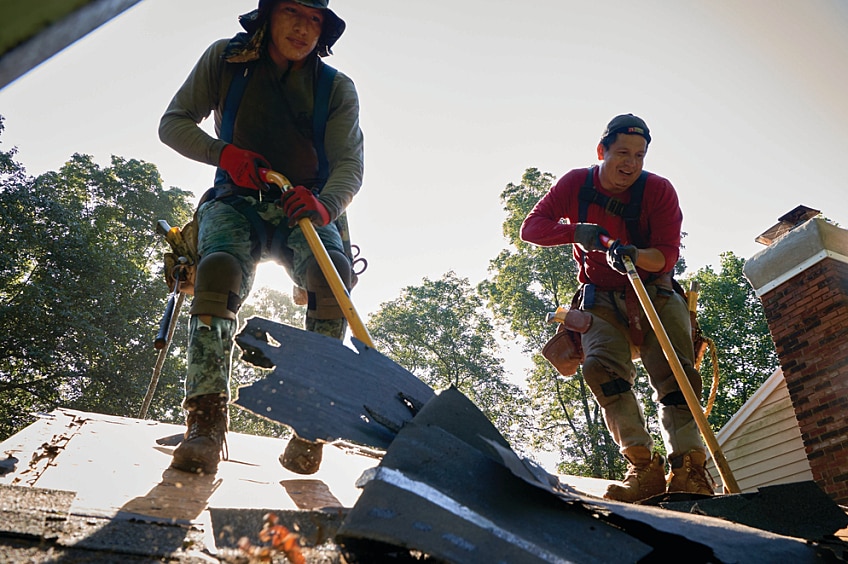Each year in the U.S., roughly 13 million tons of asphalt material gets torn off of old roofs to make way for new asphalt shingles. Currently, only about 10% of that tear-off gets recycled for use in paving and other roadway projects. That leaves about 12 million tons of waste to get shipped to landfills each year.
It should come as no surprise that waste asphalt can take a long time to break down in a landfill. After all, asphalt roofing is engineered specifically to withstand rain and sun — the very factors we count on to break down waste.
A patented recycling breakthrough — new shingles from old
As leaders in the roofing marketplace, GAF recognized a responsibility to address this asphalt waste challenge. So this month, the company announced a breakthrough shingle recycling process that has produced the industry's first asphalt roofing shingles to contain RAS (recycled asphalt shingles) from material that may have otherwise been sent to a landfill.
GAF received three patents for the new recycling process, which involves grinding torn-off shingles into a refined RAS material and ultimately reintroducing it into the manufacturing process. It has the potential to significantly reduce the amount of virgin asphalt needed to make new shingles, without compromising GAF's high product quality and performance standards.
Successful tests at our Tampa, FL, plant reclaimed upwards of 90 percent of the waste shingle material, and produced new shingles containing up to 15 percent recycled shingle content. UL, the global leader in safety science, certified the new shingles for their safety and effectiveness.
GAF asphalt shingles manufactured with recycled material from post-consumer waste shingles
The new circular roofing economy
Until today, the lifecycle of roofing shingles has been linear. That is, asphalt started out as a byproduct of crude oil, then became shingles, which became roofs, only to eventually be torn off and sent to a landfill — removed from the roofing economy.
The new GAF RAS process opens the door to eventually creating a circular, sustainable economy in which most of that asphalt remains in use as new shingles.
Virtually any manufacturer's shingles can be recycled with this process, so GAF is becoming, in effect, an equal-opportunity recycler. Long-term, the company is working to prevent torn-off shingles from going to landfills at all. For instance, GAF is already reimagining the potential impact of its Certified Green Roofer program. The company has begun discussions with roofers, waste management companies, material handlers, and other key industry players, to work out an effective and mutually beneficial process for moving material from roof tear-off, to recycling, to our manufacturing locations, and back to roofs nationwide. GAF is also busy in the laboratory, exploring the potential to use higher levels of RAS in shingles by "rejuvenating" or rebalancing, the compounds that make fresh asphalt such a durable material.
By helping to establish a clean asphalt stream, the new grinding process may eventually make high quality recycled asphalt available for a number of non-shingle applications as well, such as waterproofing, automotive applications, and more. This has the potential, if successfully scaled, to create a circular economy for asphalt in general — not just in roofing.
A local effort with global impact
Asphalt is, of course, a petroleum product, so reusing millions of tons a year could have a significant positive impact on the global environment. But for a lot of people, numbers like "millions" become virtually meaningless. So let's look at the impact a single home could have in this new paradigm.
A typical 25-square roof will generate roughly 5,000 pounds of asphalt tear-off. Traditionally, all of that material would land in a dumpster and get hauled to a landfill, where, at most, 10% would be reclaimed for use in asphalt paving. With this new process, 90% of that tear-off shingle material — about 4,500 pounds of asphalt — will get routed to a GAF recycling plant where it will be ground, sorted, and reintroduced to the market as part of brand new shingles. The tear-off from this one roof can create enough recycled content to contribute to the construction of 9 to 14 new roofs.
The future starts now
GAF is committing more than $100 million in bringing this process to commercial scale. It's also currently launching a pilot program to conduct more research, optimize the manufacturing process, and maximize the amount of recycled material we can use in new shingles without compromising quality.
The vision of a more sustainable roofing economy will demand constant innovation and teamwork across all facets of the industry. This recycling technology is a big step on that journey. Congratulations to all of the teams involved. Your leadership and creativity is helping move our entire sector forward into a more sustainable future.
For more about GAF's commitment to make a positive impact on our people, our communities, our industry, and our planet, please visit GAF.com/sustainability.

